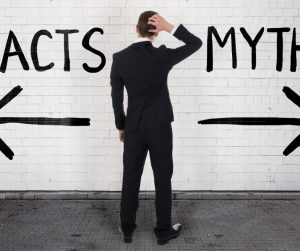Before you apply for a home mortgage loan, it’s best to get your credit in the best shape possible. The higher your scores, the lower the interest rate you’ll be charged. And of course, if your scores are too low, you won’t get a home mortgage loan at all.
If you’re dreaming of a home, the first step should be to check your own credit scores (known as FICO scores in the housing industry).
Contrary to one popular myth, checking your own credit won’t lower your scores. Only inquiries from entities that grant credit will lower your scores.
So check to see where you stand. If your scores are low, begin now to improve them.
When you read your credit report, check to make sure all of the information is accurate. Check
Step one is to always pay every bill on time – every time. That said, here are 6 more myths that can do your credit more harm than good.
Myth #2: You’ll raise your scores by having and using plenty of credit.
While it is true that you must establish credit in your name in order to prove that you can manage your money, it’s also true that you must not overdo it.
Your use of credit makes up 30% of your credit score. A current home loan, a car loan, and credit cards are all good, as long as you keep paying on time and don’t over-use your credit lines.
Each credit card comes with a maximum line of credit. To keep your scores high, you should never utilize more than 30% of your maximum credit line. In other words, if your credit limit is $10,000, the balance you carry should be no more than $3,000.
The bottom line – having plenty of credit is good. Using all of it is not good. If you’re currently carrying balances on credit cards, pay them down as much as you can each month. The bonus to that is the faster you pay down those balances, the less interest you’ll pay.
The best plan for improving your credit – use your credit cards and pay the balance in full each month.
Do use credit. People who have prided themselves on always paying cash can find themselves unable to obtain a home mortgage loan, simply because they have not established themselves as being able to handle credit responsibly.
Myth #3: You should cancel credit cards you aren’t using.
No – you should not. Keep them and use them occasionally – paying off the balance when it’s due. This shows that you have plenty of credit and have the self-control not to use all of it.
Keeping old accounts also give you a credit history. The longer you’ve held an account (and paid on time), the better for credit-scoring purposes. If all of your accounts are new, you have no history to fall back on. Unfortunately, this is one aspect of your credit score that you can’t fix quickly – it builds over time.
Your credit history makes up 15% of your FICO score, so closing old accounts can actually harm you.
Myth #4: A late payment now and then is no big deal.
Oh yes it is. Your bill paying history accounts for 35% of your FICO score. While nearly everyone has accidentally been late with a payment a few times in their lives, being late or missing payments with regularity is a big red flag to mortgage companies. It says you aren’t serious about managing your money and probably can’t be trusted to make mortgage payments on time. Late payments will not only lower your credit scores. They could prevent you from getting a mortgage at all.
Pay every bill on time. Every time.
Myth #5: Adding your spouse to your account will increase your credit scores.
Again, no. Each individual has his or her own credit scores. The only way adding your spouse could help your scores is if your spouse is the responsible one and makes sure those accounts are paid on time. Otherwise, it will have no effect.
Where adding a spouse with good credit does help, is in making a joint application for credit. The lender will look at both parties’ scores in determining whether you are jointly credit-worthy.
Myth #6: You should check your credit report often.
You can, and it won’t hurt anything, but there is no need. Check every few months to make sure no accounts have been opened in your name without your knowledge. That would be a sign of identity theft and needs to be addressed.
If you do find an error or signs of identity theft, each scoring company has instructions on line for making reports.
Myth #7: If your credit scores are low, you need to hire a credit repair agency.
Only if you like wasting money. There is nothing a credit repair agency can do that you cannot do for yourself. They may promise to remove negative information, but if the information is accurate, they cannot.
The bottom line: The only way to build and maintain good credit scores is to use credit, and use it wisely.
One more myth: You have to have perfect credit to obtain a home mortgage loan.
No, you don’t. While high scores result in the lowest interest rates, we do have mortgage loans available for those whose credit is not perfect. No matter what situation you’re in right now, we at Homewood Mortgage, the Mike Clover Group, will be glad to speak with you.
Call us today at 800-223-7409



















